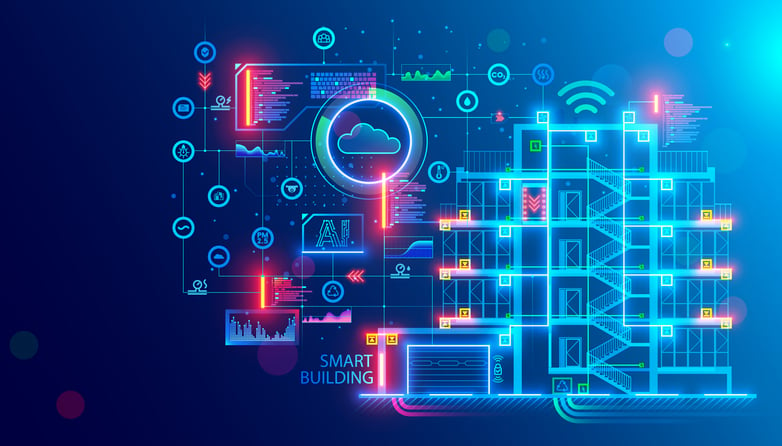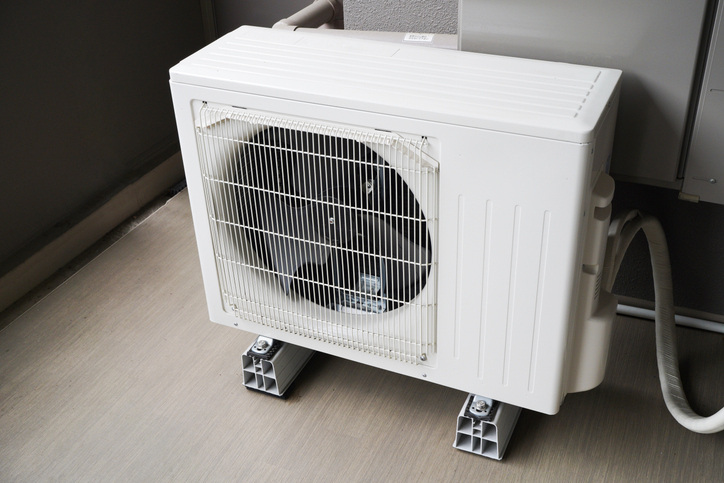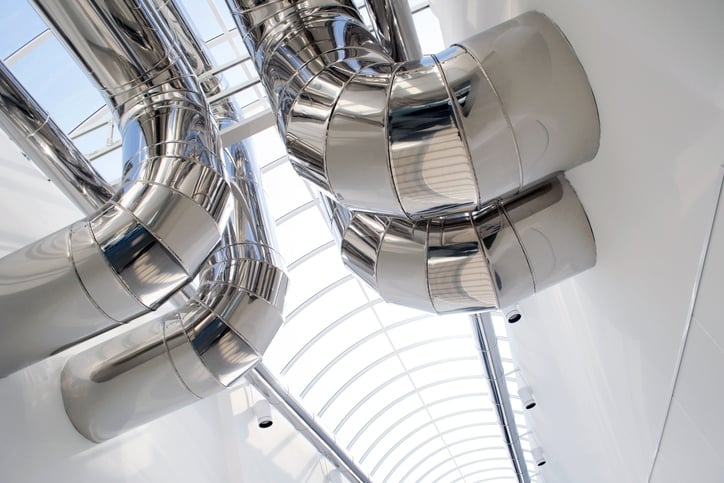IoT & HVAC: How Integrated Sensors Let Your System Do More

It’s no secret the world has only become more connected
The connected world we live and work in extends beyond communication between people at any distance. Now, it means devices of almost any sort can be networked together and exchange data through the Internet of Things (IoT) technology.
This extends to HVAC systems.
Largely in part due to advanced sensors, IoT HVAC systems are delivering a new level of performance against a more streamlined and accessible level of control.
For any HVAC system manufacturer or designer, this adds up to plenty of benefits (seven that we'll discuss later) that are hard to ignore -- especially in building or campus-wide utility management.
The Basics of IoT in HVAC Systems
A new(er) technology, the Internet of Things (IoT) refers to a vast network of physical objects embedded with sensors, software, and other technologies to connect and exchange data with other devices and systems over the Internet.
That's a mouthful. In short, the IoT lets devices talk to one another and complete certain tasks or be controlled remotely and in real time. IoT-enabled devices can range from ordinary household items (e.g. a digital thermostat) to sophisticated industrial tools.
In HVAC systems, IoT plays a transformative role by enhancing efficiency, comfort, and system management through real-time data collection and analysis.
Types of Sensors Used in IoT-enabled HVAC System Design
When you dig deep into an HVAC system design, sensor technology is truly at the heart of its functionality and performance. Put simply, without sensors strategically integrated throughout it, an HVAC system can't do its job efficiently or effectively. Another way: an HVAC system without sensors is no better than a giant fan that runs sporadically.
In HVAC systems equipped with IoT-enabled sensor technology, performance goes to the next level. The integrated sensors don't just turn the system on and off when it gets too hot or cold. Rather, they collect data in real time and adjust settings accordingly.
Some of the most commonly used HVAC IoT sensors include:
-
Temperature Sensors to actively monitor ambient temperature and engage the system for optimal comfort levels.
-
Humidity Sensors for keeping airborne moisture within an appropriate range between comfort and preventing mold growth or enabling airborne pathogen transmission.
-
Indoor Air Quality (IAQ) Sensors, such as VOC (volatile organic compounds) sensors or Co2 sensors, to detect pollutants and contaminants in the air and trigger ventilation
-
Pressure Sensors, such as high accuracy pressure sensors and static pressure sensors for HVAC, for efficient distribution of climate-controlled ventilation across different zones in a building.
-
Occupancy Sensors to identify the presence of people in a space, allowing the HVAC system to adjust temperature and ventilation based on occupancy.
Why Add IoT-Enabled Sensors to Your HVAC System? Here are 7 Reasons
Though having a seemingly obvious answer, this is a question worth exploring a bit.
Outside of being able to say your HVAC system is equipped with the latest technology and able to communicate and regulate itself in a new way, what does all this add up to?
Several benefits that simply can’t be achieved another way.
Let's dig into the seven we mentioned earlier:
IoT HVAC Sensor Benefit 1: Enhanced Efficiency and Energy Savings
HVAC IoT sensors can precisely monitor environmental conditions and adjust the HVAC operations dynamically, leading to significant energy savings. For example, by adjusting temperature settings in real-time based on occupancy and weather conditions, systems can operate more efficiently, reducing wasted energy and lowering utility costs.
IoT HVAC Sensor Benefit 2: Improved Accuracy and Responsiveness in Climate Control
With sensors distributed throughout a facility, an IoT-enabled HVAC system can accurately maintain desired temperature and humidity levels across different zones. This granularity in control ensures that each area is conditioned based on its specific needs and occupancy patterns, enhancing comfort without overburdening the system.
IoT HVAC Sensor Benefit 3: Improved Air Quality
IoT-enabled sensors can monitor air quality in real time, identifying pollutants, CO2 levels, and other factors that can impact health and comfort. This allows the system to adjust ventilation rates or activate air purifiers to maintain optimal indoor air quality, contributing to healthier indoor environments.
IoT HVAC Sensor Benefit 4: Functionality Monitoring & Predictive Maintenance
This is a big one – HVAC IoT sensors can detect issues before they escalate into major problems. This predictive maintenance approach:
- Minimizes downtime
- Extends the lifespan of HVAC equipment
- Avoids the costs associated with emergency repairs
By analyzing data trends, the IoT HVAC monitoring system can also forecast future maintenance needs and optimize maintenance schedules.
IoT HVAC Sensor Benefit 5: Enhanced User Experience
Users gain unprecedented control over their HVAC systems through intuitive interfaces on their smartphones or computers. This means they can adjust settings remotely, receive alerts about system performance or maintenance needs, and customize their environments without having to interact directly with the HVAC hardware.
IoT HVAC Sensor Benefit 6: Integration with Other Building Systems
IoT-enabled HVAC systems can seamlessly integrate with other building management systems (BMS), such as lighting and security, for holistic building automation. This integration can lead to further efficiencies and savings, as well as a more cohesive operational strategy across all building systems.
IoT HVAC Sensor Benefit 7: Data-Driven Decision-Making
The wealth of data generated by IoT monitoring systems for HVAC can be analyzed to make informed decisions about building operations, energy management, and even future building designs. This can help facility managers and building owners optimize their investments and operational strategies over time.
Another Perspective: Why Add IoT-Enabled Sensors to Your HVAC System?
Adding IoT-enabled sensors to your HVAC system isn't something you just do for the sake of it. Another way, just because you can doesn't mean you should.
What do we mean by this?
It's not always entirely necessary to have a system that's completely tricked out with IoT-enabled sensors when just a few are sufficient. Nor is it worth the investment by the end user. Sometimes it just doesn't make sense or the ROI just isn't there for your HVAC system design.
Consider the library at a major university. It's a large building that's constantly in use. It's also just one building of many at the institution that see similar use and are part of a campus-wide BMS network. Absolutely it makes sense to have a full suite of IoT-enabled sensors throughout its system.
Now consider an average home that has a basic HVAC system. The need for every sensor in the system to be IoT-ready isn't there as much. That's not to say a home can't benefit from Internet of Things HVAC technology. It can -- ask any homeowner who's been able to set the heating and cooling to a specific schedule or control their system remotely.
There are also some practical considerations with IoT sensor technology, especially when looking at upgrading to an existing HVAC system.
-
Feasibility of Installation: Whether it's the ability to connect to a network wirelessly or something as simple as accessing a power source, it's not always possible to add IoT-enabled sensors to an HVAC system.
-
Sensor Maintenance: In situations where they're relying on batteries for power, eventually their power source will need replacement -- and that can be a headache depending on where the sensor is located.
-
Ease of System Use: While the purpose of IoT-enabled HVAC systems is to enhance efficiency and control, there's a risk of complexity overshadowing convenience. Users may find themselves navigating through complex interfaces or dealing with too many options that, while powerful, can be overwhelming. This complexity can deter users from utilizing the system to its full potential, leading to a scenario where advanced features go unused or, worse, result in improper use of the HVAC system.
All of this is to say, adding IoT-enabled sensors to an HVAC system comes down to determining their value to the system. It's a decision that requires careful consideration and analysis. And when IoT-enabled sensors make sense, their benefits can be significant for HVAC system optimization and building management.
HVAC IoT Solutions: Enhanced Functionality for Enhanced Performance
The integration of IoT-enabled sensors into HVAC systems represents a significant leap forward in efficiency, control, and user experience.
There's no question about that.
However, as with any technology, it's important to be strategic -- and realistic -- about IoT-enabled sensors in your HVAC system's design. When done carefully, the integration of HVAC IoT sensor technology can lead to a truly enhanced system that delivers the highest level of performance against a finite level of control.
Bring Advanced Sensor Technology to Your HVAC System Design
Speak with one of our HVAC sensor engineers!




